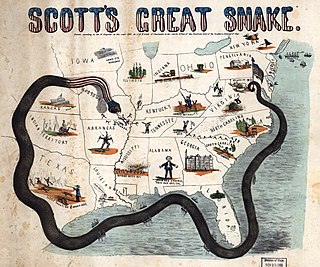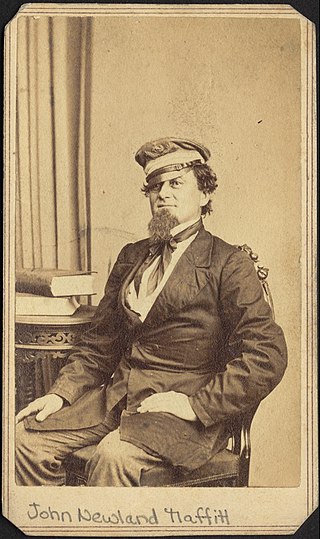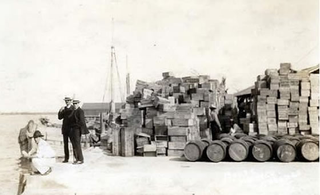
New Providence is the most populous island in the Bahamas, containing more than 70% of the total population. It is the location of the national capital city of Nassau, whose boundaries are coincident with the island; it had a population of 246,329 at the 2010 Census; the latest estimate (2016) is 274,400.

A blockade runner is a merchant vessel used for evading a naval blockade of a port or strait. It is usually light and fast, using stealth and speed rather than confronting the blockaders in order to break the blockade. Blockade runners usually transport cargo, for example bringing food or arms to a blockaded city. They have also carried mail in an attempt to communicate with the outside world.

The Anaconda Plan was a strategy outlined by the Union Army for suppressing the Confederacy at the beginning of the American Civil War. Proposed by Union General-in-Chief Winfield Scott, the plan emphasized a Union blockade of the Southern ports and called for an advance down the Mississippi River to cut the South in two. Because the blockade would be rather passive, it was widely derided by a vociferous faction of Union generals who wanted a more vigorous prosecution of the war and likened it to the coils of an anaconda suffocating its victim. The snake image caught on, giving the proposal its popular name.

Grand Bahama is the northernmost of the islands of the Bahamas, with the town of West End located 56 nautical miles east of Palm Beach, Florida. It is the third largest island in the Bahamas island chain of approximately 700 islands and 2,400 cays. The island is roughly 530 square miles (1,400 km2) in area and approximately 153 kilometres (95 mi) long west to east and 24 kilometres (15 mi) at its widest point north to south. Administratively, the island consists of the Freeport Bonded Area and the districts of East Grand Bahama and West Grand Bahama. Nearly half of the homes on the island were damaged or destroyed in early September 2019 by Hurricane Dorian.

John Newland Maffitt was an officer in the Confederate States Navy who was nicknamed the "Prince of Privateers" due to his success as a blockade runner and commerce raider in the U.S. Civil War.
Cotton diplomacy refers to the diplomatic methods used by the Confederacy during the American Civil War to coerce Great Britain and France to support the Confederate war effort by implementing a cotton trade embargo against Britain and the rest of Europe. The Confederacy believed that both Britain and France, who before the war depended heavily on Southern cotton for textile manufacturing, would support the Confederate war effort if the cotton trade were restricted. Ultimately, cotton diplomacy did not work in favor of the Confederacy. In fact, the cotton embargo transformed into a self-embargo which restricted the Confederate economy. Ultimately, the growth in the demand for cotton that fueled the antebellum economy did not continue.

The Union blockade in the American Civil War was a naval strategy by the United States to prevent the Confederacy from trading.
"King Cotton" is a slogan that summarized the strategy used before the American Civil War by secessionists in the southern states to claim the feasibility of secession and to prove there was no need to fear a war with the northern states. The theory held that control over cotton exports would make a proposed independent Confederacy economically prosperous, would ruin the textile industry of New England, and—most importantly—would force the United Kingdom and perhaps France to support the Confederacy militarily because their industrial economies depended on Southern cotton. The slogan, widely believed throughout the South, helped in mobilizing support for secession: by February 1861, the seven states whose economies were based on cotton plantations had all seceded and formed the Confederacy. Meanwhile, the other eight slave states, with little or no cotton production, remained in the Union.
The Confederate States of America (1861–1865) started with an agrarian-based economy that relied heavily on slave-worked plantations for the production of cotton for export to Europe and to the northern US. If classed as an independent country, the area of the Confederate States would have ranked as the fourth-richest country of the world in 1860. But, when the Union began its blockade of Confederate ports in the summer of 1861, exports of cotton fell 95 percent and the South had to restructure itself to emphasize the production of food and munitions for internal use. After losing control of its main rivers and ports, the Confederacy had to depend for transport on a delicate railroad system that, with few repairs being made, no new equipment, and destructive raids, crumbled away. The financial infrastructure collapsed during the war as inflation destroyed banks and forced a move toward a barter economy for civilians. The Confederate government seized needed supplies and livestock. By 1865, the Confederate economy was in ruins.

USS Vanderbilt was a heavy (3,360-ton) passenger steamship obtained by the Union Navy during the second year of the American Civil War and utilized as a cruiser.
USS Roebuck was a barque used by the Union Navy during the American Civil War.
USS Magnolia was a steamer captured by the Union Navy during the American Civil War. She was planned to be used by the Union Navy to patrol navigable waterways of the Confederacy to prevent the South from trading with other countries.
The first USS Adirondack was a large and powerful screw-assisted sloop of war with heavy guns, contracted by the Union Navy early in the American Civil War. She was intended for use by the Union Navy as a warship in support of the Union Navy blockade of Confederate waterways. Her career with the Navy proved to be short, yet active and historically important. USS Adirondack was one of four sister ships which included the Housatonic, Ossipee and Juniata.

The first USS Wando was a steamer captured by the Union Navy during the American Civil War. In commission from 1864 to 1865, she was used by the United States Navy as a gunboat in support of the Union Navy blockade of Confederate waterways.

USS Gertrude was the British blockade-running steamship Gertrude captured by the Union Navy during the American Civil War. She was placed in service by the Navy as a gunboat and assigned to patrol the southern coast of the United States for ships attempting to run the Union blockade of Southern ports. She was later the American merchant ship Gussie Telfair until wrecked in 1880.
The third USS Union was a heavy (1,114-ton) steamer with a powerful 12-inch rifled gun purchased by the United States Navy during the American Civil War.
The United Kingdom of Great Britain and Ireland remained officially neutral throughout the American Civil War (1861–1865). It legally recognized the belligerent status of the Confederate States of America (CSA) but never recognized it as a nation and neither signed a treaty with it nor ever exchanged ambassadors. Over 90 percent of Confederate trade with Britain ended, causing a severe shortage of cotton by 1862. Private British blockade runners sent munitions and luxuries to Confederate ports in return for cotton and tobacco. In Manchester, the massive reduction of available American cotton caused an economic disaster referred to as the Lancashire Cotton Famine. Despite the high unemployment, some Manchester cotton workers refused out of principle to process any cotton from America, leading to direct praise from President Lincoln, whose statue in Manchester bears a plaque which quotes his appreciation for the textile workers in "helping abolish slavery". Top British officials debated offering to mediate in the first 18 months, which the Confederacy wanted but the United States strongly rejected.

West End is the oldest town and westernmost settlement on the Bahamian island of Grand Bahama. It is the current capital of Grand Bahama, contrary to the popular belief that Freeport City is the capital of the island. It is also the third largest settlement in The Bahamas. There is one airport in West End, West End Airport, which serves mostly private aircraft. Since the 1950s, the settlement of West End has fluctuated with the rise and fall of the adjacent resort developments.

Throughout the American Civil War, blockade runners were seagoing steam ships that were used to get through the Union blockade that extended some 3,500 miles (5,600 km) along the Atlantic and Gulf of Mexico coastlines and the lower Mississippi River. The Confederate states were largely without industrial capability and could not provide the quantity of arms and other supplies needed to fight against the industrial North. To meet this need blockade runners were built in Scotland and England and were used to import the guns, ordnance and other supplies that the Confederacy desperately needed, in exchange for cotton that the British textile industry needed greatly. To penetrate the blockade, these relatively lightweight shallow draft ships, mostly built in British shipyards and specially designed for speed, but not suited for transporting large quantities of cotton, had to cruise undetected, usually at night, through the Union blockade. The typical blockade runners were privately owned vessels often operating with a letter of marque issued by the Confederate States of America. If spotted, the blockade runners would attempt to outmaneuver or simply outrun any Union ships on blockade patrol, often successfully.
SS Syren was a privately owned iron-hulled sidewheel steamship and blockade runner built at Greenwich, Kent, England in 1863, designed for outrunning and evading the Union ships on blockade patrol around the Confederate States coastline during the American Civil War. Owned by the Charleston Importing and Exporting Company, Syren made her first run on 5 November 1863, importing supplies for the Confederacy from Nassau to Wilmington. Syren completed a record 33 runs through the Union blockade, the most of any blockade runner, before invading Union forces captured her while Syren was berthed at Charleston Harbor.










